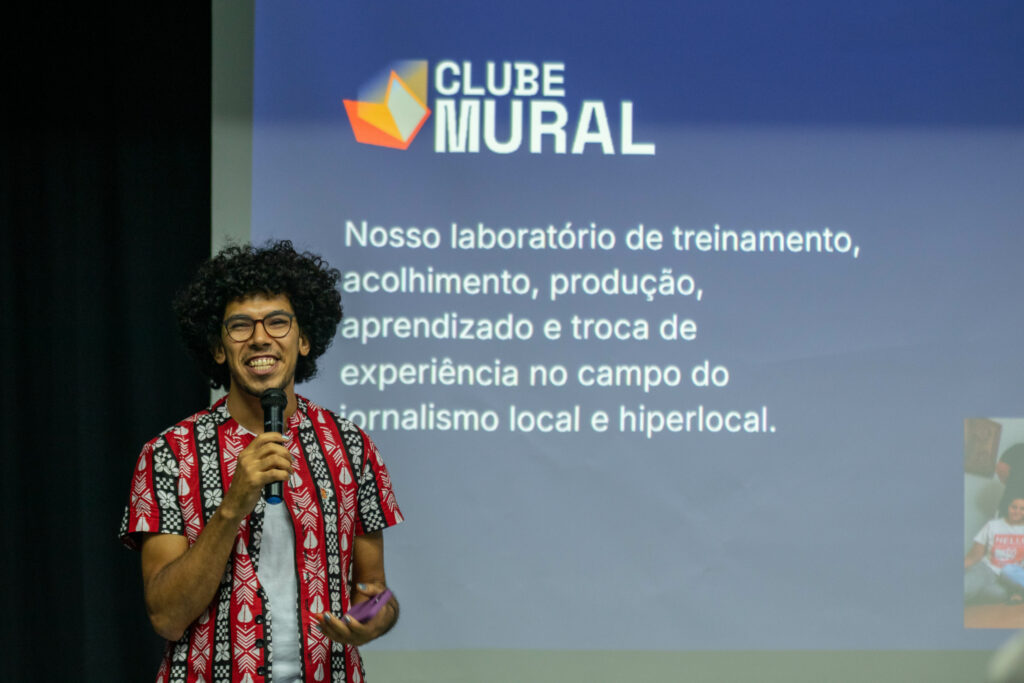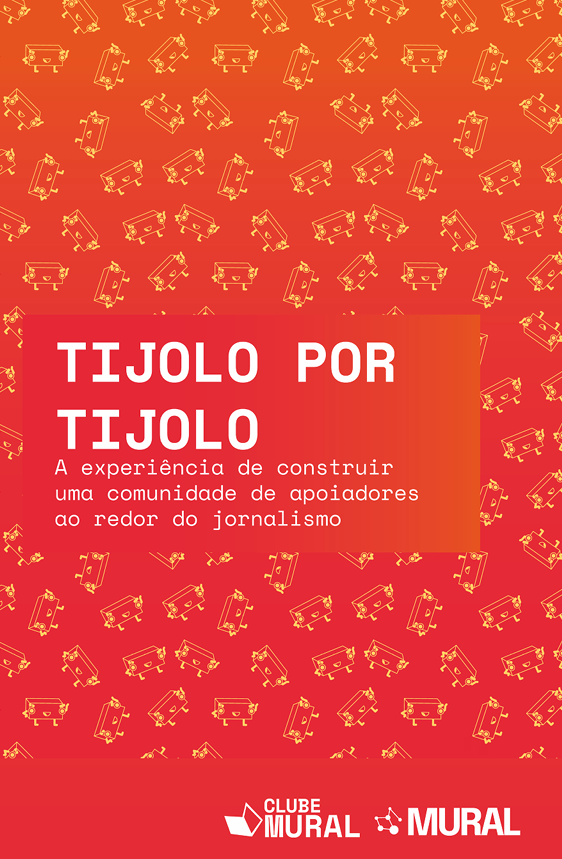In the outskirts of Brazilian cities, it's common for communities to come together to help a family build a brick house or add another floor to an existing one. In some parts of Brazil, this is called "raising a slab," or in Portuguese, subir uma laje: a group of people united by bonds of affection and solidarity building a space for shelter and connection.
This practice inspired Anderson Meneses, head of technology and business at the community news outlet Agência Mural, in "Brick by Brick: The experience of building a community of supporters around journalism." ("Tijolo por Tijolo: a experiência de construir uma comunidade de apoiadores ao redor do jornalismo" in Portuguese.) Released on Nov. 9 and available for free download, the book brings lessons from Agência Mural's experiences and those of 12 other Brazilian digital native outlets and one Colombian outlet with funding from individual donors.
Meneses told LatAm Journalism Review (LJR) that he wanted to compile the lessons learned by Agência Mural, which has been covering Brazil’s peripheral communities and conducting reader support campaigns for 14 years, while also listening to its supporters. He expanded the project to explore the experiences of other digital native outlets that also have supporter communities. Meneses interviewed staff members from 100 Fronteiras, Amazônia Real, AzMina, Matinal, Outras Palavras, Paraíba Feminina, Periferia em Movimento, Ponte, Portal Assobiar, Revista O Grito! and Sumaúma in Brazil, and Mutante in Colombia—known for its participatory journalism.

Anderson Meneses, head of technology and business at Agência Mural. (Photo: Gsé Silva / Agência Mural)
“The main lesson is: we need to run support campaigns. We need to ask for resources and make it part of journalism’s natural workflow,” Meneses said. “We need to normalize this. Reporters also need to understand the necessity of asking. And asking is not just placing a banner on the website or sending an email to readers. It happens in conversations with sources, with other journalists, in the day-to-day operations of the organization.”
Meneses' research was funded by the Comuá network’s Saberes program, which promotes the production and sharing of knowledge about community philanthropy in Brazil. The project sought to understand how journalism can cultivate community philanthropy and foster a culture of giving.
Brazil lags far behind other countries, Meneses said. Studies on philanthropy in Brazil indicate that health and education are the priorities for individual and institutional donors.
The challenge for journalists and media managers is demonstrating the impact and service journalism provides audiences, Meneses said. From there, the goal is to convince them to financially support journalistic initiatives.
“With the pandemic, we as a society understood that SUS [Brazil’s public healthcare system] is necessary,” Meneses said. “Journalism should be, for society, like SUS. It’s there every day, investigating, monitoring, presenting alternative narratives and possibilities. We still need to convey this to people, and they still need to understand the true importance of journalism.”
Ponte, one of the organizations Meneses interviewed, has covered public security from a human rights perspective for ten years and can demonstrate concrete impacts.
“Ponte has already helped free around 100 innocent people from prison,” Jessica Santos, the organization’s Relationship Editor, told LJR. Two individuals who were exonerated after Ponte’s investigations have given video testimonials featured on the page of Tamo Junto, the outlet’s membership program.
Launched in 2020, the program aimed to diversify Ponte’s revenue streams and bring its audience closer to its work, Santos said. It currently has around 350 members who contribute at least 5 reais per month. Donor support accounts for 13% of Ponte's revenue, Santos said.
One way Ponte fosters ties with supporters is through a WhatsApp group that includes the entire team and participating members. About 100 people are in the group, Santos said.

Cover of the book “Brick by Brick” by Anderson Meneses (Screenshot)
Despite initial fears that a WhatsApp group with dozens of readers might become unruly, Santos said members generally follow community rules. Some members are more engaged in conversations, while others send story suggestions or even become sources for Ponte’s reports, as many work in fields related to the organization’s coverage.
The WhatsApp group “has been a good experience for us to learn more about our readers and for our readers to understand our process,” Santos said.
Over the four years of the Tamo Junto program, Santos said, the team learned social media is not effective at converting readers into supporters, whereas newsletters are a highly effective tool.
“What most converts readers into members is the weekly newsletter. It’s not social media, not organic posts, not paid posts. In the newsletter, which is always an editorial, we always try to emphasize, ‘Look, only Ponte has been doing this kind of work for ten years. Help us ensure Ponte continues for another ten years.’ It’s an awareness-building effort,” she said.
Meneses and Santos both say the audience an organization aims to inform is not necessarily the same that will become members or financially support the organization.
“You have to understand who you want to pay,” Santos said. While Ponte aims to inform working-class people from peripheral communities, its donors live in central São Paulo and have postgraduate degrees, she explained.
“We ask for money in Tamo Junto, but we can ask for other things from other people,” she said. “We can form a group of ambassadors and ask them to share our content with others. That’s also a form of membership.”
Meneses said this year was the first time Mural conducted in-depth research about its supporters. The organization realized its supporters differ significantly from its target audience. This insight is guiding the redesign of Mural’s support campaign for 2025.
“While Mural targets urban youth from peripheral communities juggling daily life, spending two hours commuting, our supporters are journalists, academics, and teachers who view our journalism from another perspective and have a different economic standing,” Meneses said.
Another important lesson, according to Meneses, is that fundraising campaigns must be structured at every stage, from beginning to end. Moreover, they are cyclical: “the end is the beginning again,” Meneses said.
“It’s not enough to simply ask. You need effective communication, consistency in the request, and understanding of who you’re asking,” he explained. “You need to bring people in [to support the outlet], and then you need to keep them [as supporters].”
Journalist and consultant Luiza Bodenmüller has worked with supporter communities in several Brazilian digital native outlets over the past decade. She told LJR that Meneses’ research “does a great job compiling possibilities for building communities based on the Brazilian reality, which is full of unique challenges and peculiarities.”
Bodenmüller said a constant over the past decade is that support for journalism in Brazil “is still very timid,” with very few initiatives able to sustain themselves entirely on community-generated revenue.
“What has changed, on the other hand, is that challenges related to financial sustainability have become more complex,” Bodenmüller said. “Distribution is a major bottleneck and, at the same time, essential for a media outlet to become known and create a community around itself. On the other hand, there are now many more tools available, such as direct communication channels with supporters and data analysis tools that aid in decision-making for campaigns and community management.”
Bodenmüller said competition is a new challenge that didn’t exist ten years ago, as many digital native outlets with overlapping themes and approaches have created their own communities.
“This creates painful competition, given that Brazilians are not accustomed to financially supporting journalism. When they do, they tend to choose one or two initiatives at most,” she said. “As a result, the limited funds circulating within these communities are spread thin.”
Bodenmüller said the first step to build a community of supporters is to understand the audience. This requires keeping open communication channels and conducting structured surveys and interviews with followers. She said it is not possible to build a community without first listening to those already part of it and understanding their needs and desires and how the outlet can or can’t meet them.
“Community management is an exercise in persistence and resilience,” Bodenmüller said. She said that working with communities connects to the idea of journalism as a service and involves showing the public that the information, often provided for free, has value and a social role.
“Whether this translates to donations or not is up to individuals, but the fact is that these people need to feel represented, heard, and even supported before they feel compelled to contribute financially,” she said. “And that takes work, time, and must be done with great care and respect for both the audience and the team involved.”